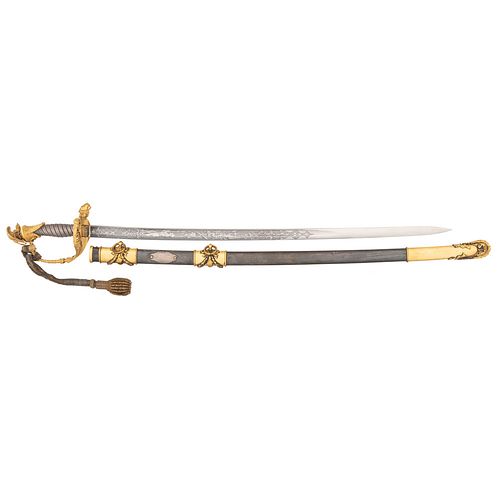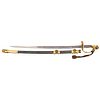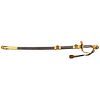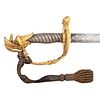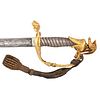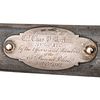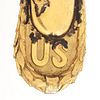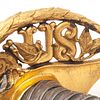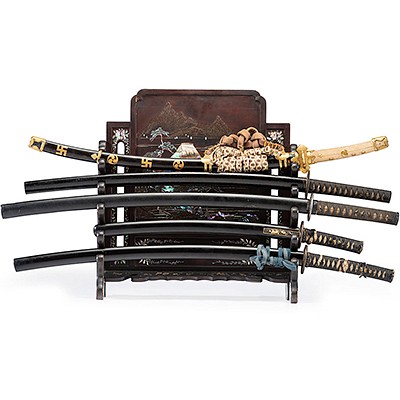Tiffany Presentation Sword of Colonel Charles B. Morton, 173rd New York Infantry Regiment, "4th Metropolitan Guard" with Documents
About Seller
6270 Este Ave.
Cincinnati , OH 45232
United States
With offices in Cincinnati, Cleveland and Denver, Cowan’s holds over 40 auctions each year, with annual sales exceeding $16M. We reach buyers around the globe, and take pride in our reputation for integrity, customer service and great results. A full-service house, Cowan’s Auctions specializes in Am...Read more
Two ways to bid:
- Leave a max absentee bid and the platform will bid on your behalf up to your maximum bid during the live auction.
- Bid live during the auction and your bids will be submitted real-time to the auctioneer.
Bid Increments
| Price | Bid Increment |
|---|---|
| $0 | $25 |
| $500 | $50 |
| $1,000 | $100 |
| $2,000 | $250 |
| $5,000 | $500 |
| $10,000 | $1,000 |
| $20,000 | $2,500 |
| $50,000 | $5,000 |
| $100,000 | $10,000 |
About Auction
Sep 2, 2020
Featuring the remarkable collection of Lore and Dave Squier (Lots 1-171), this auction promises to be the most important sale of fine Japanese Arms and Armor since the Dr. Walter Compton Collection in 1992. Cowan's Auctions dawnie@cowans.com
- Lot Description
32.25" spearpoint blade with 21.75" median fuller, 1.25" wide at ricasso. Blade finely etched and engraved throughout with elegant floral motifs and panoplies of arms complimented by a full-figure armed zouave on the obverse and a warrior in classical habit on the reverse. The "TIFFANY & Co./NEW-YORK" address stands against the frosted background in a detailed foliate panel. Obverse ricasso shows three-line "COLLINS & Co./HARTFORD/CONN./1862" address. The single-branch brass hilt has been skillfully formed into classical depictions of leathers and vines intertwining the bold "US" on the guard, with the single quillon taking on the form of a lion's head. A gilt brass eagle posed in a guarded stance surmounts the pommel, consisting of an American shield draped in finery leading to a well-formed silver grip.
The blued steel scabbard shows gilt brass en suite, consisting of American shields with celebratory classical drapery, with the top fixture showing the coveted "TIFFANY & CO/M" in a ribband. Silver presentation plaque upon the scabbard reads in script: "Presented to/COL. CHAS B Morton/173rd Regt N.Y.V/by the Officers and Members/of the/45th Precinct Police/Oct. 15th 1862."
Prior to his appointment as Colonel of the 173rd Regiment, Morton served as a 1st Lieutenant in Company "H" of the 13th New York State Militia, signing on for three months service. At the completion of his service, he returned to his home borough of Brooklyn. When the call came from President Abraham Lincoln for more regiments, Morton once again offered his service and was appointed Colonel of the 173rd Regiment, made up of policemen from Brooklyn and throughout New York.
The regiment left New York for New Orleans in early December, 1862, and served in that area throughout the war including the Battle of Fort Bisland and the Siege of Port Hudson, where it sustained heavy casualties. It was deployed further in the failed Red River Campaign under General Nathaniel P. Banks, fighting in the Battle of Sabine Crossroads. Being transferred North, the Regiment saw further action under General Philip Sheridan during the Shenandoah Campaign of 1864. In that campaign they saw duty as train guards and supply support until the end of the war, after which they participated in the Grand Review in May, 1865. They were later transferred to Savannah, Georgia, until October of that year. During their service the regiment lost 175 officers and men, including 6 officers and 38 enlisted men killed in action.
Colonel Morton returned to Brooklyn and died January 16, 1922, being an active member of Brooklyn society. He is buried in Graham Cemetery in Madison County, New York alongside his wide, Lucinda.
Included with this lot is a large collection of reproduced documents concerning Colonel Morton's service including his commission appointment, enlistment records, and pension application.Blade is bright and retains excellent detail to etchings. Gilt brass shows only minor wear and darkening, found mostly on scabbard fittings. Good blue finish remaining on scabbard with some minor oxidation from age. Bullion sword knot is likewise in fine condition. Overall a fine example of a classic Tiffany presentation sword.Condition
- Shipping Info
-
Buyers are required to pay for all packing, shipping and insurance charges. Overseas duty charges are the responsibility of the successful Bidder. Be aware that for larger and/or valuable items, shipping charges can be substantial. - If there is no shipping amount on listed your invoice, you will need to make arrangements to pick up or ship your purchase through an alternative shipping company. Our shipping department can be contacted at 513.871.1670 (ext. 219) or email shipping@cowans.com. - Shipping charges include insurance for your order while in transit. If you have private insurance we will adjust your charge to include only packing and shipping. - Please allow 14 – 21 days after payment to package and ship your purchase as carefully as possible.
-
- Buyer's Premium



 EUR
EUR CAD
CAD AUD
AUD GBP
GBP MXN
MXN HKD
HKD CNY
CNY MYR
MYR SEK
SEK SGD
SGD CHF
CHF THB
THB